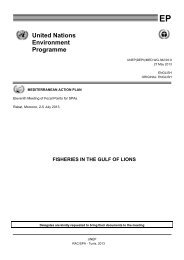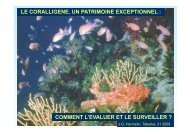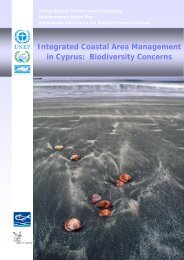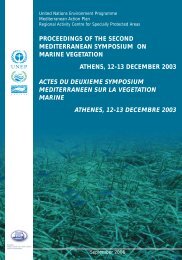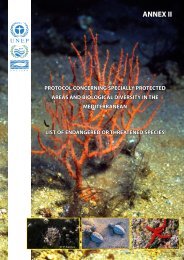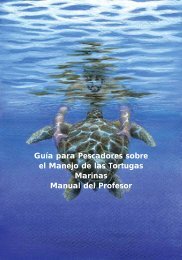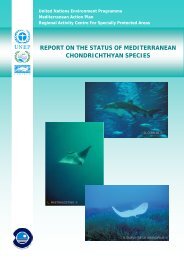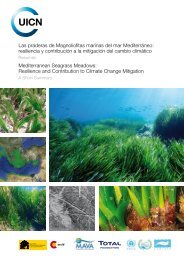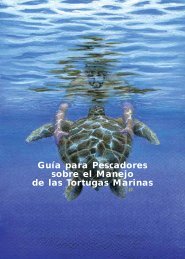Plan d'Action pour la conservation des espèces d'oiseaux inscrites ...
Plan d'Action pour la conservation des espèces d'oiseaux inscrites ...
Plan d'Action pour la conservation des espèces d'oiseaux inscrites ...
You also want an ePaper? Increase the reach of your titles
YUMPU automatically turns print PDFs into web optimized ePapers that Google loves.
6. Eleonora’s Falcon Falco eleonorae<br />
Here too, the species involved is a raptor with a very special adaptation<br />
to the marine environment: the whole popu<strong>la</strong>tion of the species nests on<br />
Mediterranean coasts and is<strong>la</strong>nds, and feeds its young by catching small<br />
migrant songbirds which arrive in the Mediterranean after the end of<br />
their own breeding season further to the north. It appears that the whole<br />
of this falcon’s popu<strong>la</strong>tion winters in Madagascar! Colonies are<br />
concentrated in Crete and the Aegean Is<strong>la</strong>nds, but other colonies exist<br />
in Spain, Italy (especially in Sardinia) and North Africa. The species is<br />
listed on Annex I of the European Union’s Directive on Wild Birds.<br />
7. Audouin’s Gull Larus audouini<br />
This is one of the few gulls of the Mediterranean which has adopted a<br />
pe<strong>la</strong>gic style of life outside the breeding season. It is a species endemic<br />
to the Mediterranean, where all its breeding colonies are situated, but its<br />
winter range is poorly known. The colonies are found on rocky islets,<br />
where <strong>conservation</strong> measures have improved its status in recent years. It<br />
occurs on Annex I of the European Union’s Directive on Wild Birds.<br />
SPECIES OF COASTAL WETLANDS<br />
This third group is made up of five species whose preferred habitat is<br />
coastal wet<strong>la</strong>nds, i.e. <strong>la</strong>goons, sandy beaches and the few inter-tidal<br />
areas of Mediterranean.<br />
1. White Pelican Pelecanus onocrotalus<br />
Like the Dalmatian Pelican, the White Pelican nests in colonies in vast<br />
wet<strong>la</strong>nds, above all in Greece and Turkey; most of the Mediterranean<br />
nesting popu<strong>la</strong>tion, whose numbers have undergone considerable<br />
decreases, follows the course of the Nile to winter south of the Sahara;<br />
other nesting popu<strong>la</strong>tions are found in Asia and Africa. It is above all<br />
important to protect nesting colonies and feeding areas around the<br />
colonies for a species which is universally recognised and enjoys a<br />
p<strong>la</strong>ce of honour in the culture of many human societies.<br />
2. Greater F<strong>la</strong>mingo Phoenicopterus ruber<br />
The Greater F<strong>la</strong>mingo used to nest irregu<strong>la</strong>rly in the Mediterranean, in<br />
<strong>la</strong>rge ephemeral wet<strong>la</strong>nds created by heavy local rainfall; for the <strong>la</strong>st<br />
thirty years it has nested regu<strong>la</strong>rly, thanks to <strong>la</strong>rge-scale protection<br />
measures, in coastal wet<strong>la</strong>nds (often artificial salt-pans) and mainly on<br />
the northern shores of the Mediterranean. It has thus been shown that<br />
this species reacts very well to protection measures and to the creation<br />
of artificial habitats. Numbers have increased considerably over these<br />
thirty years, and the species cannot be regarded as under threat. Like<br />
the pelican, the f<strong>la</strong>mingo features prominently in popu<strong>la</strong>r culture and<br />
folklore in the Mediterranean, and can act as a standard bearer for the<br />
<strong>conservation</strong> of coastal zones, even though it has a tendency to favour<br />
waters of high salinity which are often avoided by other species.<br />
74




